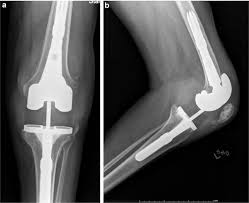Revision knee replacement surgery.
Revision knee replacement surgery has now become a specific sub-specialty all of its own. The technicalities of revision knee surgery are so difficult and the kit required is so complex and specialised, that only surgeons doing sufficient numbers of revisions per year in centres with sufficient experience and expertise should actually perform this major and challenging surgery.
Reasons for revision knee replacement surgery
There are a number of reasons why a knee replacement prosthesis might fail, and why it might need revising, and these include:
- aseptic loosening, where the fixation fails and the prosthesis starts to come away from the bone,
- infection,
- instability,
- stiffness,
- progression of the arthritis (with partial knee replacements, where they might end up needing to be revised to a total) or sometimes, very occasionally,
- ongoing pain / dissatisfaction where there is no clear-cut definite cause. (However, this latter indication probably carries with it the lowest likelihood of an eventual successful outcome compared to the other causes listed.)
The specialised kit required
One of the main problems with revision knee replacement surgery can be the amount of bone that is lost around the knee. The less bone there still is, the less one has to fix the new prosthesis too, and hence the poorer the quality of the fixation. Revision knee replacement systems therefore come with ‘augments’, which are additional blocks of metal that can be screwed onto the undersurface of each of the components of the prosthesis, to fill any gaps and to make up for any bone loss.
In addition, achieving adequate positioning, fixation and stability of the revision prosthesis components can be a challenge, and hence revision knee replacements often have ‘stems’, which are rods of metal attached to the prosthesis that go up the centre of the inside of the bone (the intra-medullary canal).
Finally, it can also be difficult to achieve sufficient stability with a revision knee replacement, and hence sometimes a hinged prosthesis has to be used (where there is a metal hinge connecting the femoral and tibial components).


Importantly, one can never tell for certain just how ‘bad’ a knee might end up being and how difficult a revision knee replacement procedure might become, and therefore all of the various bits of kit and prosthesis that might potentially be needed have to be there and available for each and every revision case, ‘just in case’. This is why this is a specialist procedure that should only really be undertaken in specialist centres by experienced surgeons.
The outcomes of revision knee replacement surgery
Generally speaking, one should consider the outcomes from a revision knee replacement as having roughly half the probability of a successful outcome compared to primary (first time) knee replacement surgery. Revision knee replacement carries roughly double the usual risks of complications, it is harder to recover from, the outcomes in terms of function and satisfaction are poorer, and the long-term prosthetic survivorship figures are lower.
Therefore, if you can avoid having to undergo revision knee replacement surgery, then you absolutely should! – and this is one of the arguments against having a knee replacement too young (unless you absolutely have to).
